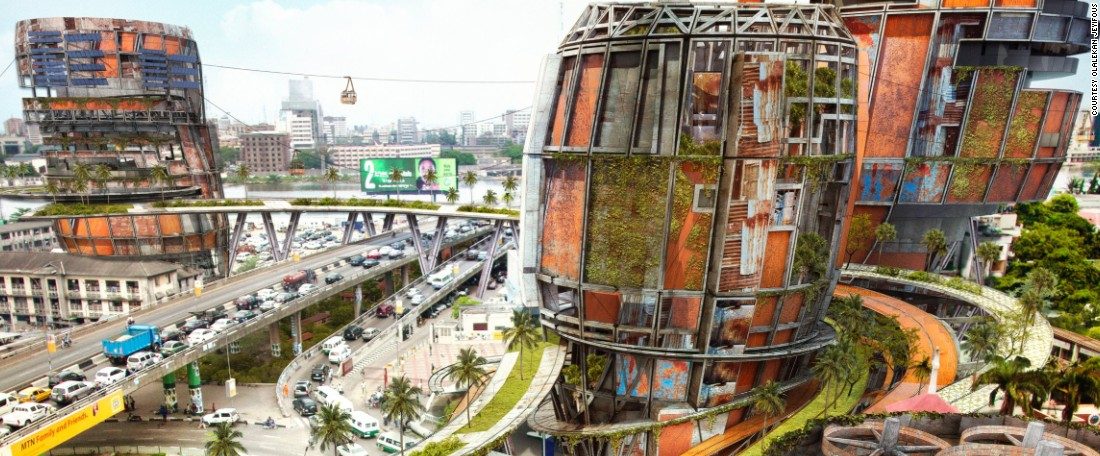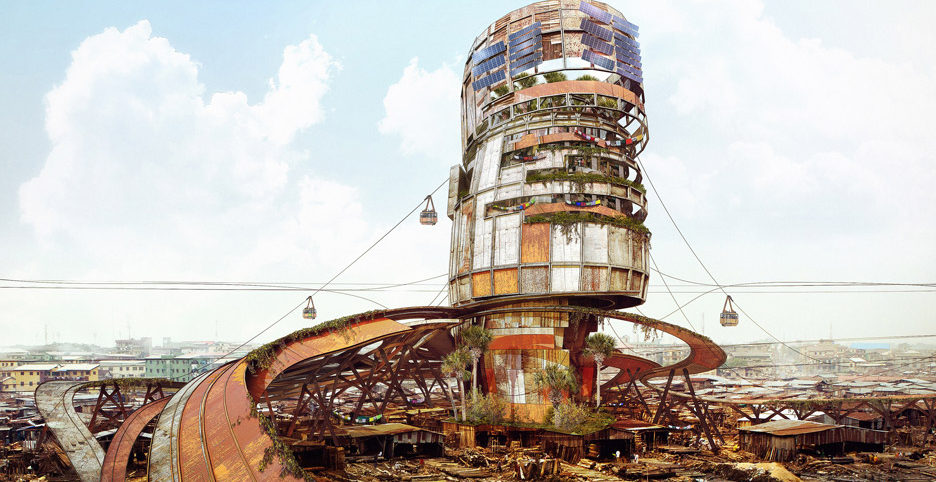Lekan Jeyifo’s Shanty Mega-Superstructures Amplifies the Lives of Lagos’ Impoverished
At the heart of all design works, there should exist a desire to attend to a need. It is in this desire that function is birthed. Either it’s the creation of a solution, a suggestion of a possibility, or the amplification of peoples plights via the creation of awareness, design is meant to be a tool as much as it is an aesthetic. Olalekan Jeyifo looked to bring to the limelight, the sufferings of the poor populace in Lagos and he embarked on this by presenting a creative futuristic representation of their dwelling places. He replaced the sleek high rise buildings in Lagos’ commercial hubs with shanty superstructures inspired by the slums in Lagos, thereby amplifying the gap between the Lagos rich and the Lagos poor. The Nigerian-born architect enthused during the presentation of his work at the 2015 Shenzhen Biennale of Architecture and Urbanism as part of the Maker Maker exhibit;
‘’I am proposing a series of digital images of ad-hoc assemblages as urban “super-structures”. These “super-structures”, whether towering or sprawling, combine attributes of improvised settlements with the scale of imposing hi-end commercial developments in an attempt to amplify some of the inherently sustainable aspects of many “impoverished” communities existing throughout the world’’.
A concept based on the exploration of Afro-futurism is what Lekan applies to his prototypical Shanty Mega Superstructures representing the sustainable properties of the slums in Lagos, Nigeria. Situating these ad-hoc assemblages in commercialized location of the mega-city is in keeping with his objectives of amplifying the poor living conditions of the slum-dwellers of Lagos. Despite the prevalence of high-rise buildings, gleaming Escalades and high-eAnd boutiques, Africa’s most populous mega city has one-quarter of its population in or nearing poverty according to a 2016 Oxford University study. It is in a bid to bring this to the fore that the Nigerian-born designer re-imagines a ‘dystopian vision’ of sprawling and towering shanty-town towers.
Shams and shanties are arranged and assembled to create sleek, imposing structures. The structures still maintains their dilapidated nature giving prominence to the less than appealing conditions the slum-dwellers are forced to live under. These superstructures are then installed in areas of commercial imminence, creating a contrasting imagery that is quite jarring;
“These images juxtapose sites of privileged and much coveted real-estate throughout Lagos, Nigeria, with colossal vertical settlements representing marginalised and impoverished communities,” Jeyifo told Dezeen.
Olalekan’s design is a clear call for action. It looks to compel the world to look at the conditions of a large part of modern urban settlement that is seemingly obscure and hidden from the sights of international observers. He tells Design Indaba; “The majority of the urban population in sub-Saharan Africa resides in slums and with rapid population growth, this percentage will only increase. It is essential that urban planning and infrastructural development reflect this fact.”
Lekan Jeyifo’s Shanty super structures is described by CNN as “Lagos’ science-fiction makeover’’. It is a representation of a futuristic alternative for the slums in Lagos. While its implementation might come to fruition in the far future, or never, Olalekan Jeyifo has successfully reminded the world that the plights of the poor in Lagos are a vital part of the city’s narrative and they deserve to be seen.






